Friday, December 18, 2009
Cool sites, links, and new stuff for you home recording nuts.
Welcome to the Home Recording Weekly blog, where I dish about recording techniques, test out cool new gear, and related home recording products.
This post is dedicated to some very informative and very hip sites that I have recently surfed across. Included in today's post are some blogs that I simply must share with you all. Also I will post about some new products that you could busy yourself with over the holidays, and some cool video sites.
First up today is a very good blog that I found. The blog is called Ronan's Recording Show, and it is the balls! I had not known about this awesome video blog but now I sure do!
This guy (Ronan) is a working professional recording studio engineer, and if that doesn't tell you something all by itself, it should. I have always tried to find folks that know a lot more than I do, and then learn from them. Ronan takes us all with him (via videos) on his travels around the globe to exotic and famous recording studios, tech shows, and even hotels that he haunts. Ronan then explains how to make better recordings with what is available to most of us. His gear reviews are very much in depth and non bias, which is very good to know. This site rocks, so check it out and watch the videos! I will add that you can see the shows, and get them downloaded at Itunes, as MP4, if that is more your speed. Make sure to subscribe and then tell your friends about it too.
Next up are some very cool links to some awesome new products!
If you own an Iphone, and you read this blog, then you know all about IK Multimedia's Groove Maker apps. Most of the music that I create is my own rock and roll, so I dismissed the whole “trance loop thing” the first time 'round. Well, look out, IK Multimedia has a new, and rather ballsy app out for all of us rock and roll nuts. It is named the “Groove Maker, Rock Ace”, and it was named after the creator, and the performer behind it, Ace, the guitarist and co-founder of the multi-platinum rock band Skunk Anansie. Please do yourself the solid, and follow the link to it. Check out this demo.
I got a cool email from the folks over at Celemony, and I thought that I would cut and paste the good stuff here, and just for you all! Here it is......
“Don't like reading handbooks? Why not just sit back then and watch the show? On our web site, you'll find numerous videos about Melodyne editor and Melodyne essential RTAS that explain their operation and technology clearly and in plain English. At the moment, there's around an hour of material available but we're already working on additional films. Another 30 minutes will be added as early as January. Why not take a look?” Here is the link to follow in order to get to the Celemony video page.
Thanks to you all for a great year! See you soon, and happy holidays!
Monday, December 14, 2009
Looking back at 2009's high points......
Thanks for such a rocking year!
This past year we took a closer look at the new EVH Wolfgang guitar, Seymour Duncan “P-Rails”, the awesome Vox “Virage” electric guitars, the Taylor “solid body classic” guitars, the new Paul Reed Smith acoustic guitars, and the Marshall Randy Rhoads amp head. Wow, some awesome gear for sure!
As for guitar and bass related software (and the related devices that work with them), this year was a stellar year indeed. We all witnessed some of the most innovative products to date come to the Home Recording Weekly Blog.
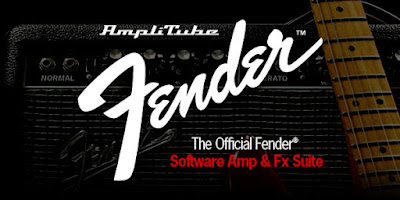
Let's start out with the reviews of all of the products from IK Multimedia, since they are truly awesome! These folks have taken some of the very best, and some of the most famous guitar and bass amps of all time and then found a way to bring these products' tones into software versions. Now they are available to the world! IK Multimedias products simply sound amazing and work just as real amps might. Here are the details, in review form....

Toontrack became the first sponsor of the Home Recording Weekly Blog, and they supplied some great products for review purposes. Toontracks products have forever changed how I approach writting and recording percussion. Toontracks products are the most realistic sounding "midi drums" that I have had the pleasure of working with!
Celemonys' Melodyne plug in software was reviewed here on Home Recording Weekly, and what a piece of software the Melodyne plug in is! The Melodyne plug in is highly recommended (if you did not just get the hint). Melodyne is changing the way that all of us less than perfect vocalists, musicians, and recording nuts get our songs closer to perfect. My work flow has forever been changed for the better, as now I can polish up everything to near perfection.
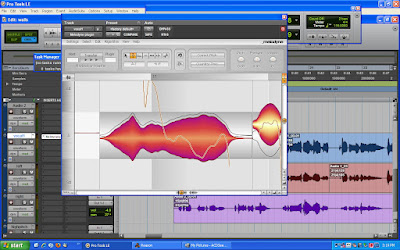
The Home Recording Weekly blog supplied some fun and informative posts too.
So, what does the Home Recoding Weekly blog have in store for 2010?
Keep a look out for some more reviews on cool music and recording products too. There are some great product reviews in the works for all of you bass players, keyboard players, and all of you home recording nuts in general! This next year looks to be the best yet (here at Home Recording Weekly), and as always it is full steam ahead.
Thanks to all of you for such a fun and exciting year here at the Home Recording Weekly blog!!! I love you, the readers, just as much as blogging and the joy that blogging brings.
A very Merry Christmas, and a Happy New Year to you all, from the Home Recording Weekly blog!
Please feel free to subscribe now, just so that you don't miss out on any of the great and informative posts that are coming soon. Feel free to post any of your comments too, as I love hearing from all of you!
Wednesday, December 9, 2009
Setting up an effects loop in Pro Tools 8.
I am constantly looking at what people are actually searching for as they stumble across the Home Recording Weekly blog. Today's topic is from a recent search on the topic of how to create effect loops in Pro Tools 8. I have quickly wrote about this very thing in the past, but I have not gone into any great depth on this awesome topic. So, lets do this!
In order to supply you all with some images, I chose to create my own quick and simple effects loop. To start I opened up a new session in Pro Tools 8. Next, I created three tracks, but all of a different type.
The three tracks that I created are a stereo audio track, a midi track, and a stereo auxiliary (aux) track.
The reason why I created a midi track is that I need to place to place the midi information, where it can be edited to precision, and then trigger the Toontrack EZ Drummer 2.0 to sound. There is a new track type in Pro Tools 8 called an instrument track, which is a combined midi/audio track, but I am not yet in the habit of using them.
When thinking about effect loops, the main point to think about is that the drums will not be 100 percent effected by the reverb, or “wet”. I will not be taking the outputs from the drums and running them directly into the reverb, and then to a stereo track. I, instead, only wish to effect a percentage of the drum signal. Hence the tutorial on “effect loops”.





The image below is of the reverb tracks' output volume slider. I will use this, in conjunction with the “send” amount/volume slider from the audio track, in order to dial in both the amount of signal getting reverb, and also how much “reverbed signal” gets heard and/or recorded. This might sound confusing, but it is not. Think about the two sliders involved here, and just what each one is doing. One is sending drum signal to the reverb, and one is sending reverb (plus drums) to the final stereo mix.

To take this theory farther, we can also send more than one track to the same effect loop. Think about having six tracks of drums, via drum microphones, and each one going to the exact same effects loop. This type of loop is also known as a “bus effects loop”, and it just makes life easier as you track out a song. Having separate loops for each part of the kit would quickly get confusing, and bus effect loops will save on your computing power by shaving the amount of tracks that you might need to effect as many separate tracks.
Have fun applying your own effect loops to your works of art. Thanks for stopping by the Home Recording Weekly Blog, and please feel free to take one second and subscribe today! Comments are always welcome too! I love to share, so send in any tips that you might have as comments, just so I can post them too! Happy music making!
Thursday, November 26, 2009
Review of Toontracks Electronic drum software.

This is a “refill” sort of package for the EZ Drummer and/or their Superior Drummer software. Once uploaded, you use either of these drum software interfaces to open up Electronic.
First off, I must add that as a rock and roll guy I was skeptical at best. Would these Electronic type of percussive sounds even peak my interest? The answer is a loud and proud “Yes”. The samples included in Electronic are just as welcome in any and all rock music as they are in hip hop, electronica, r&b, and the list goes on and on.
I found that with Electronic from Toontrack it is simple to dial up beats and sounds that sound and feel very close to industrial music, like, let's say Nine Inch Nails. The wide range of samples included will satisfy everyone from the dark industrial music lovers to the sound effect seeking Foley writers in us all.
Truth is that within only a few demos of the supplied midi files, I was hooked on Electronic. I was hearing more than I thought that I would out of this software. As I played through the tons and tons of midi loops I was finding good uses for them in my head. I can already tell that some of my previous works will need to be revisited, in order to add some files from Electronic.
Lets dig in to Toontrack Electronic, shall we? Just like all of the products from Toontrack , Electronic loaded extremely fast, and without any problems at all. In no time at all Electronic was up and running in Pro Tools 8 LE, and Electronic runs without any trouble. This means a lot to me as I like to write music and not perform “trouble shooting” tasks all day. Let me say that I was indeed up and running in minutes flat.
Just like all of the products from Toontrack , Electronic loaded extremely fast, and without any problems at all. In no time at all Electronic was up and running in Pro Tools 8 LE, and Electronic runs without any trouble. This means a lot to me as I like to write music and not perform “trouble shooting” tasks all day. Let me say that I was indeed up and running in minutes flat.
Toontrack Electronic runs in conjunction with Toontrack EZ Drummer or Superior Drummer software, as a sort of “refill package”. You must first purchase the EZ Drummer or Superior Drummer software in order to load Electronic into the entire package. Toontrack makes many other awesome refill packages, which if you are not familiar it might be worth a few minutes of your time to make the jump over to their site now and check them all out. There is a product for everyone on their site.

In order to start using Electronic, I first opened up a new song file in Pro Tools 8 LE, and then created two new tracks. One track was an audio track, and the other a midi track. The audio track “holds” the Toontrack Electronic software while the midi track is where the midi loops are dragged and dropped, and then perhaps altered to taste. Once you have worked with any Toontrack products, you will “get it” with in seconds, and all of their products work in a similar manner Electronic is a snap to work with, and a blast too!
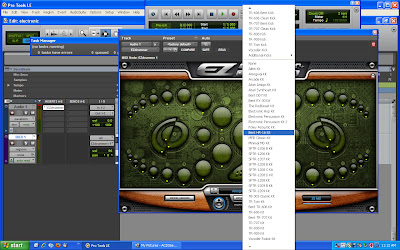 Electronic ships with 33 kits to choose from, or you can make your own kits choosing from the 33 samples available per trigger. “Wow”, this is a ton of kits! They have included a screen shot image, in a PDF file, that details just what equipment was used in order to obtain all of the samples found in Electronic.
Electronic ships with 33 kits to choose from, or you can make your own kits choosing from the 33 samples available per trigger. “Wow”, this is a ton of kits! They have included a screen shot image, in a PDF file, that details just what equipment was used in order to obtain all of the samples found in Electronic.

There are an amazing amount of triggers too, on the Electronic interface, with 41 to choose from! This, along with some other goodies, is why the mixer in Electronic appears to be a lot wider than the one in Toontrack EZ Drummer; it is a lot wider! All of the triggers on the interface are numbered so confusion is not possible.

Since we are speaking about the mixer, Toontrack has given us all a lot more in Electronic. What do I mean by this? Well, if you take a look to the right hand side of the mixer you will notice some extra sliders that do not appear in EZ Drummer. These extra, and new sliders are effects dubbed “Tape, Attack, Bias, Sub Tube Echo, and Chorus”. They all sound great too!
These sliders add their specified effects to the kit as a whole, or to each piece of the kit that you choose. Adding different midi tracks to your DAW will help to isolate just which piece of the kit gets their own effects, instead of “effecting” the kit as a whole. Simply writing a piece on a separate midi track, and then adding effects to it as a whole seems to be the easiest to me, but I am new here.
 One little item that shipped with Electronic (that I found to be a great idea) was the included PDF file image for your midi keyboard “key map”. It shows where all of the samples and related midi information lives on a midi keyboard. This PDF file could easily be printed out and placed near your midi keyboard for an easy reference. Maybe other companies do this too, as I am not sure, but I thought that this was a nice little extra.
One little item that shipped with Electronic (that I found to be a great idea) was the included PDF file image for your midi keyboard “key map”. It shows where all of the samples and related midi information lives on a midi keyboard. This PDF file could easily be printed out and placed near your midi keyboard for an easy reference. Maybe other companies do this too, as I am not sure, but I thought that this was a nice little extra.To wrap up this review, Toontrack has become the industry leader when it comes to realistic samples of classic and unique percussion, in easy to use software applications. The supplied midi files in Toontrack products are written, played, and supplied by some of the best musicians alive today.

Toontrack products load fast, are easy to use, and simply sound amazing. This is the stuff that we all want to hear, right? I mean, who wants to work all day with hard to use interfaces, writing our own midi, using crappy samples? Well, Toontrack is to the rescue! Go out and start your own collection of the many diverse Toontrack products today.
Thanks for stopping by “Home recording weekly” and make sure to subscribe today. After all, you don't want to miss out on any reviews, tips, or news right? The subscribe button has not functioned in the past, but now it is fixed and working! Comments are also always welcome.
Tuesday, November 17, 2009
Reason Record versus Pro tools 8
This post is once again brought to you all from recent reader interests. Quite a few folks are looking into, and looking to learn about the subtle differences between Propellerhead Reason Record and Digidesign Pro Tools 8.


Pro Tools 8 is the newest offering from Digidesign. This piece of recording software is the industry standard. What sets this apart from so many other DAW's out there is its ability to get very deep into even the most minute details of the music that you are writing or creating, easily.
Pro Tools 8 ships with a ton of great (and top notch) effects all built in. The effects found in Pro Tools 8 include reverbs, delays, EQ's, limiters, and compressors. They are are not overly draining on CPU's, they sound amazing! All home recording enthusiasts (new or old) will not “want” or “need” for any effects other than these.
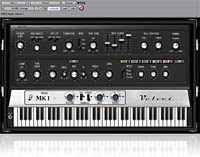
Let us not forget the amazing plug ins that are available and/or virtual instruments that come with Pro Tools 8. Here is a link to just two sound samples of their virtual instruments, Velvet and Expand. These virtual instruments and plug ins are easy to use and they simply sound awesome.
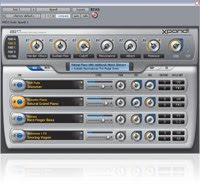
One thing that I say about Pro Tools 8 in general is that it is set up more for an engineer, and not so much for musicians. Pro Tools 8 is for making music so do not misunderstand this part. What I meant by that is that most of the settings and adjustments for things like volume levels, panning, effect settings and the like are usually displayed in digits, and not with actual dials. Everything in Pro Tools 8 seems to be adjusted in numbers (like from 1 to 100) and this takes time to get used to.
A separate issue that you will need to sort out is just which version of Pro Tools 8 to purchase. Let me explain. Pro Tools 8 comes in a few different sizes, or editions. Pro Tools 8 “LE” is the “limited edition”, but do not be fooled by this name. You will have the ability to enjoy rather high track counts and multi-effects across many of said tracks. You will not notice a lack of their famous editing features either just by using Pro Tools 8 “LE” edition, but the price is a lot lower. However, where this is for your home and not a huge studio setting the “LE edition” is a great fit. Many pros have a “LE” studio in their home.
Pro Tools 8 “LE” ships with a digital interface that manages many tasks for you. The digital interface manages your midi ins and outs, converts your analog audio signals (vocals, guitars) into digital signals (ones and zeros) and then routes this into your computer. Think “M-Box” and you will know what I mean. The pre amps are very good, and the sound that they produce can be amazing. You can also apt for a “M-Audio” version of Pro Tools 8 just for a M-Audio interface, but why?


In order to use Reason Record you will need to purchase some sort of Digital interface. You must turn your analog signals into digital signals so that Reason Record can edit it. At this point in time Reason Record does not ship with one. However their a some great choices out there. Tascam and M-Audio are perhaps two of the more popular choices for Digital interfaces.
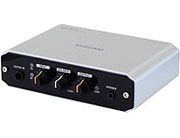
Reason Record is set up like the real thing, when compared to Pro Tools 8 . You will find actual dials in Reason Record instead of numbers. You will see actual effect units instead of a few sliders with titles and number values. You will notice that the input section (mixing console) looks like what you would see in a studio setting. I like these simple features a lot as that is what I am both used to seeing and working with. It is true that Digidesign is getting better at designing things in this like fashion, but they are not quite there as of yet.

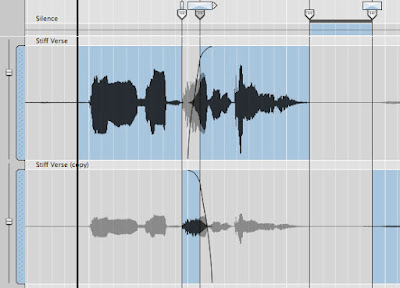
If you are making your first move into home recording and you wish to use a software based DAW then do your homework first. If cost is of a concern, then count your pennies and write out a complete list of parts that you feel that you will need. Ask yourself if you prefer working as a musician might (with real looking effect units, actual dials, and mixing consoles) or if you can understand the number system. Ask yourself if you need the finished work to be sent to other folks in order to finalize. That will require a similar file type as theirs, so do keep such things in mind. Both of these systems will allow you to audition the changes that you are making to your audio in real time; so either way it is just a question of “how do you like to work”.
Friday, November 13, 2009
10 famous Guitarists and their guitars that made us envious.
1) The EVH Kramer “Frankenstein” guitar is number one on my list. The kid from sunny California that had a mischievous smile sure had one cool guitar. I had a job where I had to wear a name tag at the same time that EVH was doin' his thang with "ole Frankie" and it was painted just the same as this guitar on the back side of the tag. I would flip it over for inspiration while the days at work dragged on and on.Eddie Van Halen is on this list of ten twice, and this is no mistake. Heck, I wanted to be him. Imagine the long days full of Valerie and his choice of guitars.... Check them out all here, on this EVH fan site!
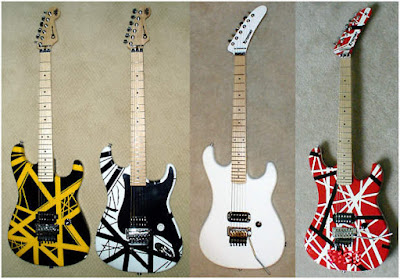
2) Slash and his Gibson Les Paul collection is the envy of the world, but lets look instead at his use of a very different sort of guitar. What else does Slash play? Lots! The B.C. Rich Mockingbird guitar was first spotted strapped on the guitar gurus back while in the “You could be mine” video. This stuck out like a splinter in my eye, this is the same band, but what is this...... a different guitar? No whiskey bottle? Slash can play, and he can play whatever he wants. 
3) Steve Vai and his Jem of an Ibanez 777. Since the time of 1980, Steve has been hard at work. He was in Frank Zappas band back then, but would go on to help create a guitar revolution. While even more fame and time in the spotlight came around 1985 while Steve was playing for Diamond David Lee Roth, and this is where the Jem process started. Jem guitar company made several guitars for Steve to play while on the Roth tour, and then Ibanez made some copies of these guitars along with Steve's demanding specs. The rest is Rock and roll history. Here it all is, on this great site. Check out this site if you truly love these guitars.
 4) The unmistakable Washburn N4 guitar, namesake of Nuno Benttencourt.
4) The unmistakable Washburn N4 guitar, namesake of Nuno Benttencourt.
This guitar stood out for being a stripped down monster. This axe had Nunos blood and sweat sunk way down into it. This was a mans guitar. Nuno himself perhaps “single handedly” put Washburn guitars on the worlds map. These guitars were sold out all across the U.S., and getting one meant getting put on a waiting list.  5) The EVH Ernie Ball Music Man guitar. This guitar took the world by storm for its balance and playability alone. Forget the endorsement, this guitar rocks! I can hear Sammy singing the “C'mon babey”....and even the spinning Floyd Rose wah bar still comes to mind as seen in the video for “Finish what you started”. What a fresh sound that was. We can all purchase our very own classic EVH Ernie Ball Music Man guitars by visiting this site . Be warned, they are not cheap.
5) The EVH Ernie Ball Music Man guitar. This guitar took the world by storm for its balance and playability alone. Forget the endorsement, this guitar rocks! I can hear Sammy singing the “C'mon babey”....and even the spinning Floyd Rose wah bar still comes to mind as seen in the video for “Finish what you started”. What a fresh sound that was. We can all purchase our very own classic EVH Ernie Ball Music Man guitars by visiting this site . Be warned, they are not cheap.

6) The amazing Eric Clapton Stratocaster. The first version of “Layla”, in Eric Clapton's Derek and the Dominoes days, is pure Strat. Not the “slow hand” applied to the MTV acoustic shows of last decade, which was played on his now famous Martin guitar. Although the default color is black, as is the nickname of “Blackie” applies, they are available in other colors too. Just as long as you like the maple necks, you are in good company.
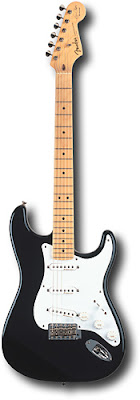
7)Lita Ford's BC Rich Warlock “kissed us all deadly” back in the day. I can recall some very dirty thoughts as I watched Lita have her way with that B.C. Rich Warlock in that very video. No keg party was complete without one or two plays of that golden song. Then, as the night became drunker and drunker, you could always find a “hook up” while the song “Close my eyes forever” played. What a pairing of voices, that is Ozzy and Lita.... 
8) The David Gilmour Stratocaster. Just because of the melodic solos that this man and the best rock band in all of recorded time has composed with this type of guitar. The tone is all Fender and given up to us all by David.
 9) ZZ Top and their Dean guitars caught my attention as they spun their “fuzzy explorers” around in some great music videos. Ah, the age of MTV, back when it was more than just hair product commercials. I lived on the Canadian border, and they were known as “zed zed top” over their, but that is just a side note for you all. Visit this site to see a ton of their custom instruments.
9) ZZ Top and their Dean guitars caught my attention as they spun their “fuzzy explorers” around in some great music videos. Ah, the age of MTV, back when it was more than just hair product commercials. I lived on the Canadian border, and they were known as “zed zed top” over their, but that is just a side note for you all. Visit this site to see a ton of their custom instruments.
10) James Hetfield of Metallica and his arsenal of Gibson Explorers. Once more, a guitar is just a tool. It is what an artist does with this tool that creates art. It is with great fondness that this mans art, along with his pals, came into my life. No other band was as unique as Metallica at the time. At the beginning their “metal head” followers stood up to much ridicule, but stood up none the less. Hind sight is always 20/20 in such cases. These folks were on to something. Out of all of James's white Gibson Explorers, the one that had “more beer” written on it was the one that jolted me to attention. Do you suppose that touring Germany had an influence on that slogan? Here is link to a great site featuring all of his equipment.

And not on this list of ten but defiantly one guitar that was perhaps my defining moment was a unique Gibson Les Paul. I knew a little about guitar quality but it wasn't known to its fullest until I saw the Gibson “blonde beauty” Les Paul. With gold tossed all over this guitar, I couldn't help but to fall in love upon the sight of this piece of art. This guitar was the same ole Gibson, but yet not the same at all. Read all about it beloe the image.
 This stunning Blonde Beauty guitar featured a AAA flame maple top in a natural finish that lets you see the beauty of the wood, and an exotic 3-piece flame maple neck. It has all the great sound and features of the Les Paul Standard, like Burst Bucker Pro pickups, a tune-o-matic bridge, trapezoid inlaid rosewood fretboard and single-ply neck and body binding, but with upgraded gold hardware. Well done!
This stunning Blonde Beauty guitar featured a AAA flame maple top in a natural finish that lets you see the beauty of the wood, and an exotic 3-piece flame maple neck. It has all the great sound and features of the Les Paul Standard, like Burst Bucker Pro pickups, a tune-o-matic bridge, trapezoid inlaid rosewood fretboard and single-ply neck and body binding, but with upgraded gold hardware. Well done!I have fixed the subscribe feature, so please subscribe now just so you do not miss out. I am so very sory that I didnt realize that the feature was not working! Also, your coments are needed, and that feature is working now as well. Thanks for the long wait!
Friday, October 30, 2009
A closer look at Richie Sambora and his guitars.
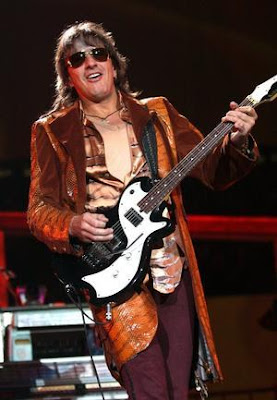
My “Burger Boss” pulled his car into work one day and a new sound was soon filling the air. He was pumping out music from a band that sounded rather new and exciting. He let me know that it was a group named Bon Jovi, a name that I had to write down because I would certainly forget it. Who ever they were I liked them instantly.
Flash forward several more months....
I was on my way to Mass, for a sold out show. It was an outdoor venue, and Bon Jovi was headlining. Along with Bon Jovi an old version of a “nobody group” named Extreme was opening if that tells you how long ago it was. Let me just say that the event changed my life, and concerts would soon become who I was. Guitar driven music would become the reason for waking up each and every day.
Can you think, or hear, the tone that Richie's music would poses if he had stuck with Gibsons? I bet it would just about smell like Santana, with less southern influence though. Be that what it may, Richie was destined for single coil cleanness. As we first met Mr. Sambora, he had a Kramer strapped on his back and that was his first popular endorsement, the Richie Sambora Kramer guitar. The Richie Sambora Kramer had a Floyd Rose bridge (a favorite of Richie), three humbucker pickups, and various phase switches and coil taps to round out the tone.






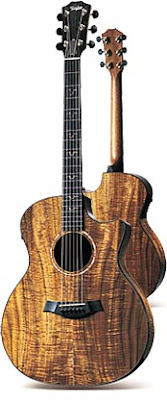

Wednesday, October 28, 2009
Making drums sound more powerful, part two.
This is just my work flow and you may or may not like using this same method. Let me explain why I like to use midi drums in my songs.
First, and probably most importantly, as a songwriter I like the control that midi drums give me. I can quickly switch the drum sample out with other drum samples in order to find the perfect fitting sound for each song. I can also place these switches at any point in a song, or double different parts. But more on this stuff in a few paragraphs....
Moving on, I like to edit each piece of a drum kit separately (like adding reverb on just a snare). Midi drums allow me to place each piece of the kit onto its own track. I can get confused at times if I place too much midi information onto just one midi track. I also like to play with volume and velocity as I write, and this is easy when each piece is on a separate track. This technique also allows for easy automation of all aspects of a drum kit. Effects parameters, or the effect types themselves most often need automation in order to get the most out of them. Automating effects and parameters like distortion, panning, velocity, wah, reverb, and volume is just easier when each piece of a kit is on its own track..
Lastly, midi information is just so darn easy to work with! I can easily copy and paste the midi information from one part of a song to any other part in a song in a swipe of the mouse. I can automate the pasted parts differently in order to make them sound just a little bit different too. Editing midi is a snap, well, once you get used to writing with midi anyway.
Toontracks Superior Drummer 2.0 actually took this “each piece of a kit gets its own track” technique and ran with it. Their Toontracks Superior Drummer 2.0 software allows for adding track by track effects, or the adding of effects to each piece of a drum kit separately. Toontracks Superior Drummer 2.0 ships with some awesome effects too, and these effects take up very little processing power. Look here, back to an older post, to read more about Toontracks Superior Drummer 2.0.
We all enjoy placing a snappy delay on a kick, a reverb on a snare, and effects like distortion on everything else that we can get away with. Here is one more idea that I would like to share with you all.
What I like to do is to copy a kick line, and paste it onto a new track. Now I can pick a second kick drum sample for this track and now I will have a more interesting and a way more powerful kick drum. Sometimes I will change the drum samples between the verses and the choruses, just for some dynamics. This idea works great on snares also, and please have some fun with this idea. Try adding a sub bass, or even metal strikes as doubled samples.
One thing that I try to do when writing rock and roll drum lines is to decide what a person could actually play. Layering drums and adding sub percussive beats on top of the main beat may be too much for a person to actually play out live. However, it could be done by joining other drummers to the band. If I am using two percussionists for a song idea, then I like to make sure that the midi that I write would and could be played by just two people. However, with rock music I try to keep it real. I stay away from impossible notes and over the top drum lines. Dance music is a different beast all together, and different rules might apply though.
To get a live player vibe, I like to sum the outputs of all the drum kits pieces to a stereo track. Then, I will add a send/return effects loop in order to add some room sized reverb. I like to play the wet track along with the dry track, just to make it sound authentic. Keep the reverb short and life like, as a little reverb goes a long way. Long decays on reverbs can get quite awful sounding, so listen close to what you are placing on your tracks. Make sure the delays don't get too confusing for the listener by making sure they are short too.
Another idea is to only add a send/return reverb loop track to only the hi hats tracks. That way it will sound as if a drum room was used to record the whole drum kit. With the illusion cast, you can then dazzle the listener by adding some cool delays and reverbs to the rest of the kits pieces.
Tuesday, October 13, 2009
How to make drums sound way more powerful, part one.
The bottom line……
Never mind getting the best possible sounding drum kit right off the bat. Work at getting the best possible drum line, or performance that you can write. Try alternate times, switching parts around, and place importance on song dynamics. Building up tension, and then releasing it is the name of the game.
With the drums written, now you can consider the approach that you will use in order to fine tune the drums. The different approaches are vast in number, but in this post I will detail some of the most common.
If you are serious about your music, then you want to get the best sound entering the recording device as you possibly can, and by doing the least amount of work in order to get it. Why we record lame sounds and think we can fix it later in the mix is beyond me. But we all have done it. Think about this time tested chant “crap in, crap out”. That is just what someone said to me once, and it makes a lot of sense.
The term “Powerful drums” brings several different approaches to mind. These approaches may include EQ, volume, velocity, panning, effects, and the like. I suppose I should describe each approach to you, and then let you use them at your own discretion.
There are no two songs that are alike. Each song that you work on will need different ways of editing a drum sound. Learning each trick will add tools to your tool chest of ideas. Then you can use one or all of these ideas and add them to any of your songs that you wish. Learning to know what each idea will bring to your finished song is the key. You will learn just what “trick” a certain song could benefit from, and learn it in no time at all. However, never be afraid to try new things!
If you jumped over to the link that took you over to an older drum post, then you get the idea of panning your drum kits as if the listener is sitting on the drum throne. I will not bore you any longer on that idea. I have always tried to get the panning completed first, no matter what the tone or impact of the individual drum hits sounds like.
The next two ideas up my sleeve are to add EQ and compression, but not necessarily in that order. Compression can shave off some top end, or add some “wallop”. EQ is often added after such tools in order to bring back frequencies that were lost, but not as a rule.
You need to assess your type of drums (drum machine, real drum kit, ToonTrack Drum software, ect.) that are inputting into your audio recorder, in order to come up with a working signal effects routing path. This is just about critical in order to achieve getting your fat and powerful tone. You will develop a routine plan of attack all of your own, depending on where your drums actually come from each time. This will determine the exact protocol for the addition of EQ and Compression, and in just which order you will want to add these effects plus others.
Let me explain a few of the different processes.
Recording a real drum kit with microphones….
You might just be “summing” the microphones into a mixer, and exiting the mixer with a “stereo out” pair. This stereo pair probably then enters your recording device. I would most likely first run the stereo pair into a compressor in order to smooth out the spikes, and to bring in more of the drum kits tone. EQ’ing would come next. Make sure to then go straight into your recording device. Keep in mind that adding too much EQ and/or compression before the recording device can be a bad thing. Go light, as you will not be able to remove it later.
Drum machines straight to your recording device…….
Drum machines most often enter your recording device as a stereo pair, so routing them into the recording device is easy. However, drum machines and their quality of sound differ from unit to unit. Look at exactly what sort of sound is entering the recording device. Are the snares and kicks attacks entering the red line? Do the kit pieces sound good tone wise? Getting this information now will determine the plan of attack.
Most often times, recording your drum machine into your recording device dry will sound o.k., but not stellar. Listen to the drum machines onboard effects, and make a decision about using those effects or your favorite effects elsewhere. You must decide if you record the drum machine “wet” or “dry”. “Wet” is with effects, and “dry” is without. Either way is fine, but once again you can’t “undo” the wet in the recorded drum mix. Read on for more advice.
Recording drum machines “dry” and “wet”.
First, let’s take the recorded “dry” tracks and add some effects to them.
Using either an auxiliary bus approach to add the effects to the dry drum machine tracks, as an aux send return, in parallel, might just work fine. This adds the effected “fix” along with the recorded dry drum machine tracks, and records them together. This method allows us to dial in just the right amount of “fix to the mix” by adjusting how just much “dry versus wet” enters the final recorded track.
The other option, if you are sure just what the drum machine needs “right from the get go”, is to add the effects as they enter your recording device. This can be done by taking the stereo outs from the drum machine, to the recording device, and adding your EQ and Compression as the stereo pair are recorded.
This can be done as a series fix, or a parallel fix. Series is in “out one device and into another”, and parallel is recording all effects “to, and with” the dry signal, just like we did above. The difference is that we will not record the dry drum track.
The best and the safest way to fix “lame-o” drum machine tracks is to record them dry, and then fix them from there. Exactly how you accomplish this is going to become your style.
Software based or Midi drum tracks……
This is the easiest sort of drum track to alter and/or to add effects to, as there are so many different approaches in which to accomplish these chores. Here is how I like to do this.
I like to use a separate midi track for the drum lines, the fills, and the cymbals. This makes getting the separate velocity and volume levels perfect, and for the whole song.
Once your drum lines are written, consider using the drum software itself (the source for the drums) to complete all of the panning, EQ, volume, velocity, automation, and any other fixes that you might deem necessary. This will take care of most of the problems that might pop up in the drum mix. Using one “place” or one area to fix all of the troubles is a great idea. This makes your workflow easier to remember and simple to dial in.
With that finished, listen to what you are left with. What ever is troubling you now needs to be fixed in either one of two ways. You can fix it either before your drum tracks “see” the recording device (or in either series or parallel), or after they “see” the recording device. Let me take that principal further.
Recording the drum tracks with a compressor inline will smooth the transient spikes. If this is what you wished to fix, then do just that. If you like the audio, but think it needs just a touch more “tom tone”, then add your compression along with the dry signal via an aux send/return, and record a stereo pair from that send/return. That way, you will get the original and the compressed all mashed together in one stereo track.
You might need to return to the software in order to adjust some minor EQ fixes, after the compression is added, but don’t freak out, as I mentioned before “that happens”.
Avoid adding effects like delays and reverbs until your drum track is finished (as far as its impact and tone) and recorded. These effects might sound better if they are triggered from just one certain kit piece, or added to the kit as a separate auxiliary send/return track. Besides, adding such effects at each step along the way will cause them to add up, or pile up, linearly, and might just sound terrible! Use the same size reverbs, and apply them as few times as you must. The same is true for EQ fixes by the way.
Drums are often the first instrument recorded. How are you going to know if the effects are going to fit the song that you have started to write? Adding the effects after more and more of the separate parts are written is the way that I like to do things. That way, you are not stuck with a drum line that is too wet.
Stay tuned for part two of this series. I will discuss getting your recorded drums to sound as if they are being played live, sound coherent in the mix, and even sound more impacting over all.


